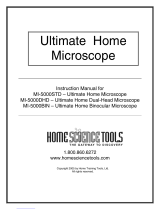Page is loading ...

5615 Raytown Road, Kansas City, MO 64133 U.S.A
Tel. 816-353-4787 Fax. 816-358-5072
Email: info@ken-a-vision.com www.ken-a-vision.com
Such a program of planned preventive maintenance, involving a thorough
cleaning, checking and adjustment of mechanisms is recommended. Qualified
personnel with the proper training should perform this work.
Ken-A-Vision has quality technicians on staff to repair or service your microscopes.
Contact us at 1.816.353.4787 for more details.
WARRANTY: TEN YEAR WARRANTY AGAINST DEFECTIVE PARTS AND WORKMANSHIP.
Research S
Research S
c
c
op
op
e
e
Instruction Manual
T-3300
kav.instrcman.t3300.pc.v2
2001
c

Focus
Focus the T-3300 microscope by observing with the 10x objective and 10x
eyepiece on the side without diopter ring. Rotate the coarse adjustment knob to lift the
stage until the image of the specimen can be seen roughly, then rotate the fine
adjustment knob. A sharp image can then be obtained. Take caution not to let the
objective lens touch the specimen. Observe the image with the other eyepiece and
adjust the diopter ring until the sharp image is obtained. Change the magnification of
the objective as required by turning the nosepiece.
Depending upon specimen density and objective magnification, the light level
should be adjusted. If the light is excessively yellow, place the blue filter in the
condenser filter holder. To eliminate light irregularity when using low-power
objectives such as 4x and 10x, raise or lower the condenser using the condenser
adjustment knob. Close down the condenser iris diaphragm to the smallest size for
observing a specimen with low contrast.
BULB REPLACEMENT
Before replacement, unplug the instrument. Open the lamp window in the bottom
plate by pulling the window knob. After the lamp has cooled, carefully remove it from
its socket and replace with a new lamp. Be careful not to touch the new lamp with your
fingers. Never operate the microscope illuminator unless the lamp window is securely
in place.
CARE AND MAINTENANCE
Our product is a precision instrument. Routine maintenance on your part is limited
to keeping the microscope clean. Never leave the microscope with any of the
objectives or eyepieces removed. Always protect the microscope with the dust cover
when not in use.
Cleaning the Microscope
Dust is best removed with a soft brush of soft cloth. More persistent dirt, such as
fingerprints, grease and oil, may be removed with soft cotton or lens tissue lightly
moistened with lens cleaner.
To clean immersion oil off the oil-immersion type objective, use lens tissue, soft
cotton or gauze lightly moistened with lens cleanser.
When the microscope is not in use, cover it up with dust cover, and store in a dry
place not subject to mold.
All optical and mechanical equipment requires periodic servicing to keep it
performing properly and compensate for normal wear. Anticipating this need by
establishing a schedule of regular preventive maintenance will help to assure long life
and sustain optimum performance by your instrument.
RESEARCH MICROSCOPE
APPLICATION
Research Microscope is a professional laboratory instrument for the modern
biology and medical sciences. Its modular design allows for a full range of
accessories.
SPECIFICATIONS
• 10x Widefield Eyepiece w/ pointer
• 45° Inclined Rotating Head
• Coarse and Fine Coaxial
Focal Adjustment
• Binocular Head
• Rack & Pinon
Abbe NA 1.25 Condenser with Iris diaphragm and filter holder.
• Low Position Coaxial Mechanical Stage
• 20 watt Halogen Lamp
• DIN Achromatic Objective Lens: 4x, 10x, 40x, and 100x(R)
MICROSCOPE PREPARATION
Set the viewing head onto the microscope arm and lock the head by
tightening the lock screw. Position the condenser with the handle of
aperture diaphragm conveniently accessible. Swing the filter holder outward and insert
the filter when it is necessary.
OPERATION
Built-In Illuminator
Plug the microscope power cord into a suitable grounded electrical outlet. Move the
illuminator switch to the “ON” position. To obtain the desired illumination, adjust the
light control dial. Put the specimen to be observed onto the stage of the
microscope and clamp it firmly with the mechanical stage clamp. Bring the spot of
specimen to be observed into the center of stage hole by rotating stage X – Y
movement knobs.
Eyepiece
Set the interpupillary distance by moving the eyepiece tubes together or apart until
the full field of view is visible by two eyes at the same time.
kav.instrcman.t3300.pc.v2
/


